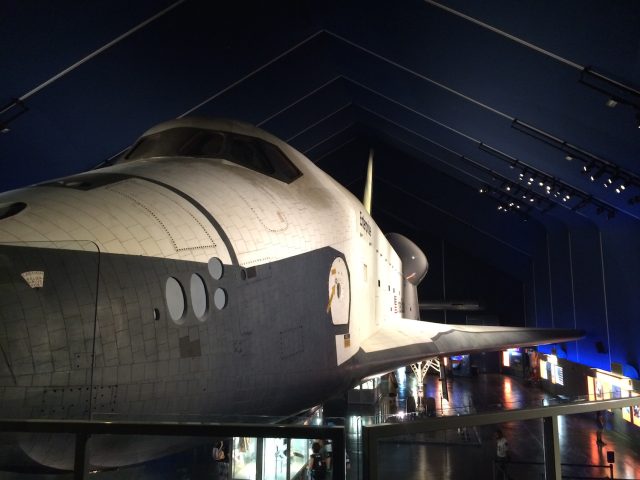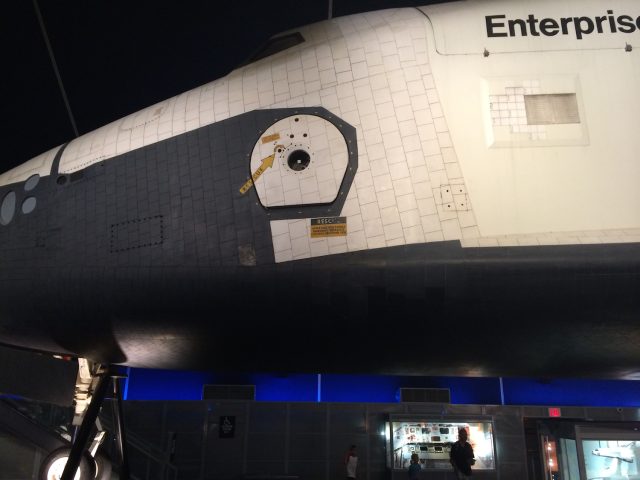NEW YORK—The space shuttle Enterprise has been ensconced aboard the USS Intrepid for just over two years. It sits in a silent warehouse, dramatically lit so it appears to be cruising in a dark vacuum. Tourists can wander around or under it at the exhibit; they can even walk up some stairs and get nose-to-nose with the Enterprise, staring down its long axis through a thick layer of glass.
While the whole thing evokes space exploration, the Enterprise has never actually made it out of Earth's atmosphere. The shuttle on display has the distinction of being one of NASA's biggest workhorses despite earning perhaps the least amount of glory among the entire space shuttle fleet. So while visitors look closely at the Enterprise, they can see what has stopped it from earning more prestige and examine the scars its body has retained from experimentation during its years in service from 1976 through 2012.

Like the USS Enterprise it's named after, the Enterprise shuttle is more or less fake. Where a shuttle's $40 million engines should be, the Enterprise has mere mockups, covered by a cone for aerodynamic purposes. A shuttle should be speckled with reaction control system thrusters to help maintain or change its orientation in space. But since the Enterprise has always been Earth-bound, it has nothing but covered holes.
The shuttle's skin is also not space-ready. Eventually, NASA figured out that the best dorsal surface material for shuttles entering and leaving space was a variety of blankets, some made from Nomex felt and others from quilted surface material. The Enterprise's skin is more like that of a plane, with polyurethane foam tiles to simulate the surface of actual shuttles. It uses fiberglass tiles on the leading-edge panels where the shuttle gets the hottest on re-entry instead of the reinforced carbon-carbon required to withstand 2,300ºF temperatures.
The Enterprise was never outfitted for space because it was used mostly in approach and landing tests to see how a shuttle would fall back to the ground (the last two flights without a tail cone) as well as launch pad testing. Its first flight took place on February 18, 1977, mated with a modified Boeing 747 called the Shuttle Carrier Aircraft, and NASA tried releasing the shuttle to study its fall for the first time on August 12.

NASA originally planned to retrofit the Enterprise to put it into service as a real shuttle, during the construction of Columbia in the 1970s, and to replace Challenger in the 1980s. Both times it was overlooked in favor of more financially sensible solutions: Challenger was cheaper to build from a frame the first time, and Endeavour was a cheaper replacement for Challenger because it could be put together from spare parts.
Up close, visitors can see the leading edge where NASA borrowed tiles from the Enterprise to figure out why Columbia broke apart on re-entry in 2003. At the time, investigators suspected that the breakup started when a piece of foam separated from Columbia's external tank and struck its delicate (and expensive) leading-edge carbon-carbon tiles. When they tried shooting the same foam at Enterprise's stronger fiberglass tiles and the tiles still took damage, they knew they were on the right track.
The Enterprise also bears some scars from its last move, when a worker rapped on some of the tiles on the port-side landing gear door and cracked them.
Visitors aren't allowed anywhere inside the shuttle, which is closed to everyone except select staff and employees responsible for maintaining and restoring it (plus the occasional visiting astronaut dignitary). The Intrepid's summer volunteers get a single tour of the interior as a perk. The inside is mostly stripped aside from structural elements, curator Eric Boehm told us, which gives it a surprisingly cavernous feel for a shuttle that is normally crammed with stuff. Still, you might hardly notice given all the excitement of being inside a space shuttle.
The Enterprise is sometimes dismissed as a lesser museum artifact due to the fact that it is not a "real" shuttle. And for a certain glory-centric definition of shuttle, that's true. This was a tool for experimentation that helped us figure out how space exploration should work; essentially one of NASA's most elaborate and expensive playthings.
Listing image by Casey Johnston
reader comments
104